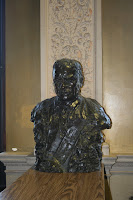 In this July 4th's edition of the Boston Sunday Globe, Eric Moscowitz wrote of the 100th anniversary of the Esplanade, whose opening was highlighted with fireworks on Independence Day in 1910. The article speaks of the ups and downs with the history of this most famous of the city's landmarks.
In this July 4th's edition of the Boston Sunday Globe, Eric Moscowitz wrote of the 100th anniversary of the Esplanade, whose opening was highlighted with fireworks on Independence Day in 1910. The article speaks of the ups and downs with the history of this most famous of the city's landmarks.In the 3rd floor stacks of the Library, one can find a pamphlet The Charles River Esplanade: Our Boston Treasure, published in 2000 by the Metropolitan District Commission (now known as the Department of Conservation and Recreation) and written by Linda M. Cox, Founder of the Esplanade Association. The booklet is digitized and note the link in the record to the online version. This small booklet is indeed a treasure in itself with its rich history of the site.
Among many other items housed in the State Library about this famous landmark are items about the flamboyant and much celebrated conductor, Arthur Fiedler, who presided at fifty July 4th concerts. An online biography of this famous conductor by PBS (WGBH Boston) includes the following about his tenure:
"Among memorable events of the Fiedler era were the Fiftieth Anniversary Esplanade concert of July 4, 1978; the building of the Hatch Shell in time for the Esplanade season of 1940; the occasion of the Maestro's seventy-fifth birthday, when his son Peter presented him a surprise gift on behalf of the whole family: an honest-to-goodness, full-size fire engine(!); and the Esplanade concert of July 4, 1976, which was heard by over 400.000 people, declared by the Guinness Book of World Records the largest single audience for a classical music concert. "
The Fiedler footbridge was designated by Resolve 86 of 1953 and in 1980, not long after his death, the General Court memorialized him. This law is available in the library and has also been digitized and can be found online with other years' Acts and Resolves.
It reads:
Chap. 567. AN ACT DIRECTING THE METROPOLITAN DISTRICT COMMISSION TO RESERVE A SITE FOR A STATUE MEMORIALIZING ARTHUR FIEDLER.
Be it enacted, etc., as follows:
The metropolitan district commission is hereby authorized and directed to locate and reserve a site for a statue at the Hatch memorial shell located in the Charles river reservation in the city of Boston, in memory of Arthur Fiedler, the father of the Boston Pops.
Approved July 16, 1980
On to another 100 years and more.
Pamela W. Schofield
Reference Department
State Library of Massachusetts











